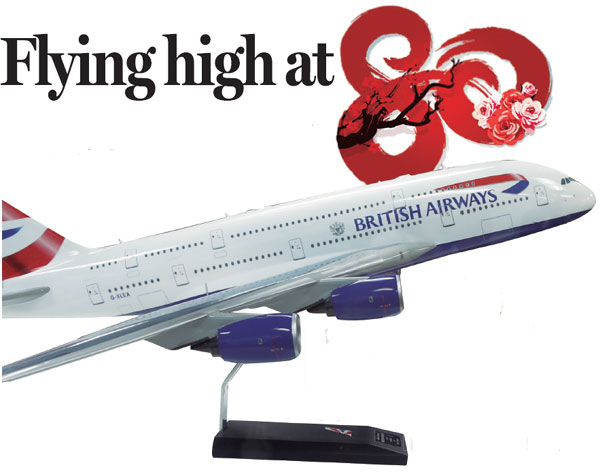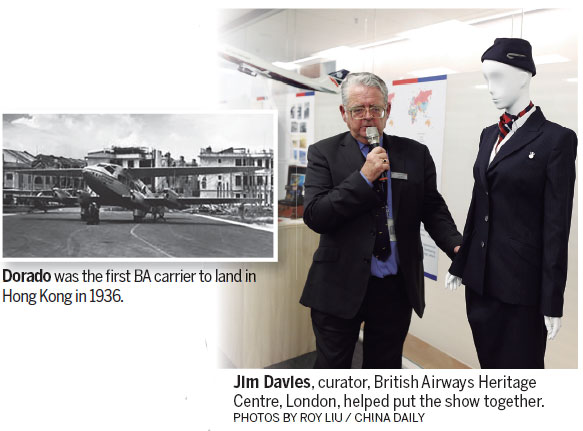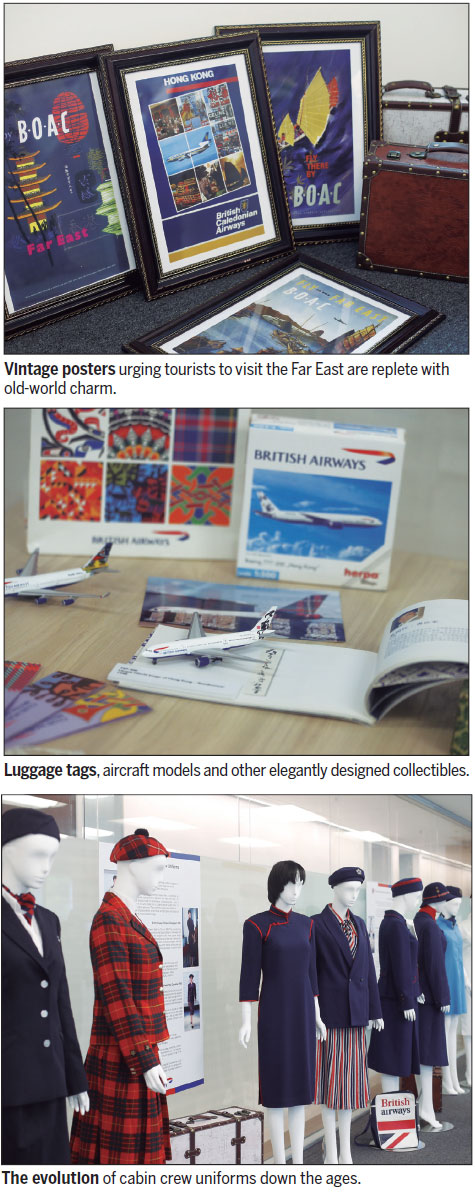Flying high at 80
Updated: 2016-05-06 06:43
By Chitralekha Basu(HK Edition)
|
|||||||||



British Airways and Hong Kong go back a long way. Their journey together is the subject of an exhibition featuring vintage posters, aircraft models, uniforms and other memorabilia. Chitralekha Basu reports.
Much of the nostalgia over British Airways' 80-year-old relationship with Hong Kong has to do with two airport facilities that are no longer there - the Kai Tak Airport in Hong Kong which ceased operations in 1998, and the Great West Aerodrome in London which has since morphed into London Heathrow. Jim Davies, curator of British Airways Heritage Centre in London, points to a photo of a Boeing 747 flying low over the Kowloon skyline in the 1990s ready to touch down at the now-defunct Kai Tak Airport. Even as he proudly shows off a model of the British Airways Airbus A380, apparently the world's largest civil aviation vehicle which has been flying between Hong Kong and Heathrow since October 2013, Davies remembers the old Kai Tak Airport with love and longing.

The history of British Airways in Hong Kong is a story worth memorializing and showcasing. The first British Airways (then Imperial Airways) flight was an airmail carrier, arriving in Hong Kong via Penang on March 24, 1936, 10 days after the post was dispatched from London. Passenger-carrying flights took off soon afterwards.
The route from London to Hong Kong was a bit of an arduous journey spread out over 10 days and entailed getting on and off 23 times to change vehicles, stock up on fuel and overnight hotel stays. Alternatively, to at least some of the airlines' first passengers the experience must have seemed like a 10-day adventure, with happy discoveries to be made along the way - stopping by at Paris, onward by train to Brindisi, Italy and then on to Athens, Greece, before staying overnight in Alexandria, Egypt surely had their own allure. The trip got more exotic by the day as passengers traveled to Gaza, Palestine, and stayed overnight in Baghdad, Iraq, followed by stops in Basra, Iraq, Kuwait, Bahrain and Sharjah in the United Arab Emirates. The next stops were Gwadar and Karachi in Pakistan. Then it was on to India, including an overnight stay in Jodhpur, followed by stops in Delhi, Kanpur, Allahabad and then Calcutta (now Kolkata). Brief touchdowns in Sittwe and Yangon in Myanmar culminated in an overnight stay in Bangkok until the passengers arrived in Penang, Malaysia. From there they boarded a De Havilland DH86 aircraft which flew them to Ho Chi Minh City and Da Nang in Vietnam before touching down on the shores of the Fragrant Harbour.
Touching on milestones
Davies and his team - which includes students of Media, Culture and Creative Cities program of the Department of Sociology at the University of Hong Kong, as well as members of the UK-based British Chinese Heritage Centre - have put together a show that offers a bird's eye-view of British Airways' 80-year journey to Hong Kong. It's a journey where the plot points coincide with the milestones of Hong Kong's own aviation history - from the phasing out of Kai Tak to the Concorde's touching down on the city for the first time in 1997.
The exhibits include vintage posters, models showing the evolution of costumes worn by British Airways' crew down the ages and aircraft models, including the very first carrier to touch down on Hong Kong - a four-engine 10-seater De Havilland DH86 G-ACWD lovingly christened "Dorado". Other memorabilia associated with air travel - luggage tags, boarding passes, menu cards, Polaroid camera used by cabin crew to take photos of passengers excited by their first time on board an airplane are equally fascinating.
British Airways staff, travelers from Hong Kong and visitors to the city have recollected their on-board experiences in the oral history section. "Many of them share the same nostalgia towards Kai Tak, and this is probably more about the 'emotional significance of flying' in the 1980s where you can see groups of friends and relatives seeing people off at departures, and happily and eagerly waiting for their return at arrivals," says Davies, noting the value of re-bonding with family members over flying "at a time when there was no internet, smartphones and you had to spend a fortune on IDD calls".
Former crew members have recalled seeing students already homesick on the flight and how they used to distract them with small children's games and toys, says Davies. "You nearly never see anyone shed any tears inflight nowadays."
Contact the writer at basu@chinadailyhk.com
(HK Edition 05/06/2016 page8)